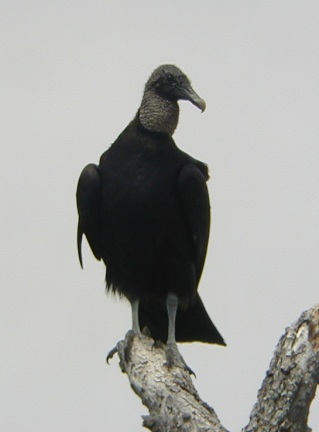
BLACK VULTURE
L 25" W 58"
Taped in Wise County in January 2001
FIELD IDENTIFICATION: The Black Vulture is a large, black bird with a patch pale primary feathers that can be seen from below. The dark gray head is featherless with dark beak. The legs and feet are pale. The wing span is 70 inches which is slightly smaller than the Turkey Vulture. It has a relatively short tail. The nestlings are a buffy colored. It rarely makes a groan or hiss sound. They feed off of carrion. It ranges over the southeastern United States, which includes part of Texas.
The Black Vulture is easily confused with the slightly larger Turkey Vulture. Immature Turkey Vultures have dark heads like Black Vultures, but adult Turkey Vulture have red heads. In flight, when you cannot see the head color, shape is a good field mark. Black Vultures have a much shorter tail than Turkey Vultures. The trailing edge of the wing (the edge farthest from the head) seems almost uninterrupted by the short, rounded tail. By comparison, the Turkey Vulture's tail juts out of the wings' trailing edge. Color of flight feathers can differentiate the two vultures, also. All of the Turkey Vulture's flight feathers are paler than the body. On the Black Vulture's wings, only the base of the primaries are pale. Flight style helps identify a mystery vulture. Turkey Vultures know how to soar. On the other hand, the Black Vulture flaps far more frequently. If there is a group of vultures soaring, look for vultures that flap more often, and those will be your Black Vultures. Also, if you see a lone vulture that flaps a little often, check to see if it is a Black Vulture. Black Vultures have little or no dihedral, unlike the strong-flying, rocking and tilting Turkey Vultures.
by Claire and Mary Curry

Photo by Mary and Claire Curry on Greenwood Road, Wise County in May 2001